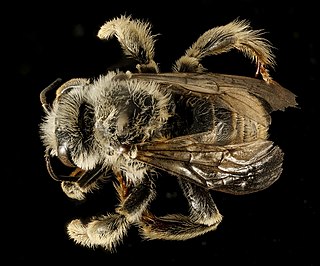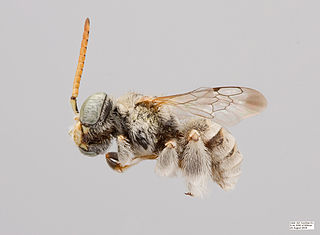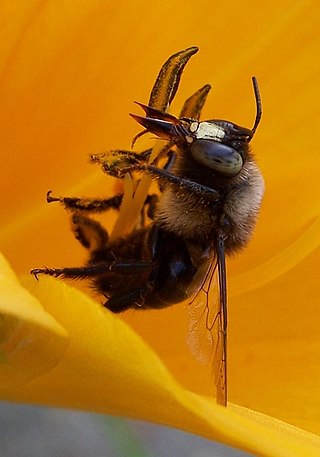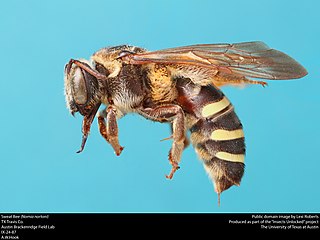Hesperapis is a genus of bees in the family Melittidae. There are at least 30 described species in Hesperapis. The genus is very uncommon and is restricted only to coastal barrier islands in the Gulf of Mexico and dunes of the Great Lakes. Its abdomen is flattened and its integument or "skin" is soft compared to other groups of bees.

Nomia tetrazonata is a species of sweat bee in the family Halictidae. It is found in Central America and North America.

Svastra is a genus of long-horned bees in the family Apidae. There are at least 20 described species in Svastra.

Eucera fulvitarsis is a species of long-horned bee in the family Apidae. It is found in North America.

Heterostylum robustum is a species of bee flies in the family Bombyliidae. It has a nearctic distribution, being found in Canada, Mexico, and the USA. It is a bomber fly, parasitizing bees and wasps by launching its eggs into their nests its ovipositor. It is the principal parasite of the alkali bee Nomia melanderi, an important alfalfa pollinator across Washington, Oregon, Idaho, and Wyoming. Other hosts of the fly include Nomia nevadensis bakeri, Dieunomia triangulifera, Calliopsis anthidia, Nomia scutellaris, and Halictus rubicundus.

Dieunomia is a genus of sweat bees in the family Halictidae. There are about nine described species in Dieunomia. These bees are relatively uncommon, and are larger than almost every other genus in Halictidae other than Nomia. The wing has two submarginal cells, and the usual bent vein of the basal vein is only weakly present. The male has greatly dilated middle tarsi.

Anthidiellum is a genus of rotund resin bees in the family Megachilidae. There are more than 60 described species in Anthidiellum.

Diadasia australis is a species of chimney bee in the family Apidae. It is found in Central America and North America.

Melissodes communis, the common long-horned bee, is a species of long-horned bee in the family Apidae. It is found in Central America and North America.
Melecta separata is a species of hymenopteran in the family Apidae. It is found in North America.
Dieunomia triangulifera is a species of sweat bee in the family Halictidae. It is found in the central United States from central Illinois and Minnesota westward to Utah and southern New Mexico. Adult Dieunomia triangulifera closely resemble Dieunomia nevadensis, specifically Dieunomia nevadensis arizonensis.

Xenoglossa is a genus of large squash bees in the family Apidae. There are about 11 described species in Xenoglossa.

Anthophorula is a genus of bees in the family Apidae. There are more than 60 described species in Anthophorula.

The dotted miner bee is a species of miner bee in the family Andrenidae. Another common name for this species is Cresson's andrena. It is found in North America.
Nomada crotchii is a species of nomad bee in the family Apidae. It is found in North America.

Xylocopa tabaniformis, the horsefly-like carpenter bee or mountain carpenter bee is a species of carpenter bee in the family Apidae. It is found in Central America, North America, and South America. It is 12–18 millimetres long and black. Males have yellow hair on the thorax.

Paranthidium jugatorium is a species of bee in the family Megachilidae. It is found in Central America and North America.

Nomada affabilis is a species of nomad bee in the family Apidae. It is found in North America.

Nomia nortoni is a species of sweat bee in the family Halictidae. It is found in Central America and North America.

Svastra obliqua, the sunflower bee, is a species of long-horned bee in the family Apidae. It is found in Central America and North America.





















